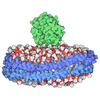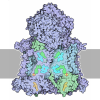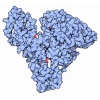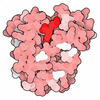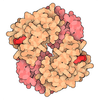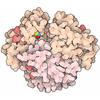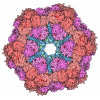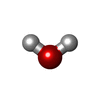+ Open data
Open data
- Basic information
Basic information
| Entry | Database: PDB / ID: 7kjr | |||||||||
|---|---|---|---|---|---|---|---|---|---|---|
| Title | Cryo-EM structure of SARS-CoV-2 ORF3a | |||||||||
 Components Components |
| |||||||||
 Keywords Keywords | TRANSPORT PROTEIN / VIRAL PROTEIN / SARS-CoV-2 / coronavirus / viroporin / membrane protein | |||||||||
| Function / homology |  Function and homology information Function and homology informationhost cell lysosome / symbiont-mediated activation of host reticulophagy / Maturation of protein 3a / Defective ABCA1 causes TGD / high-density lipoprotein particle receptor binding / peptidyl-methionine modification / HDL clearance / spherical high-density lipoprotein particle / Scavenging by Class B Receptors / negative regulation of response to cytokine stimulus ...host cell lysosome / symbiont-mediated activation of host reticulophagy / Maturation of protein 3a / Defective ABCA1 causes TGD / high-density lipoprotein particle receptor binding / peptidyl-methionine modification / HDL clearance / spherical high-density lipoprotein particle / Scavenging by Class B Receptors / negative regulation of response to cytokine stimulus / protein oxidation / regulation of intestinal cholesterol absorption / vitamin transport / blood vessel endothelial cell migration / cholesterol import / SARS-CoV-2 modulates autophagy / negative regulation of heterotypic cell-cell adhesion / apolipoprotein A-I receptor binding / apolipoprotein receptor binding / ABC transporters in lipid homeostasis / negative regulation of cell adhesion molecule production / negative regulation of cytokine production involved in immune response / HDL assembly / high-density lipoprotein particle binding / negative regulation of very-low-density lipoprotein particle remodeling / phosphatidylcholine biosynthetic process / glucocorticoid metabolic process / acylglycerol homeostasis / phosphatidylcholine-sterol O-acyltransferase activator activity / positive regulation of phospholipid efflux / Chylomicron remodeling / cellular response to lipoprotein particle stimulus / Chylomicron assembly / high-density lipoprotein particle clearance / phospholipid efflux / chylomicron / high-density lipoprotein particle remodeling / positive regulation of cholesterol metabolic process / reverse cholesterol transport / lipid storage / phospholipid homeostasis / high-density lipoprotein particle assembly / chemorepellent activity / low-density lipoprotein particle / lipoprotein biosynthetic process / cholesterol transfer activity / cholesterol transport / high-density lipoprotein particle / very-low-density lipoprotein particle / endothelial cell proliferation / regulation of Cdc42 protein signal transduction / HDL remodeling / : / cholesterol efflux / Scavenging by Class A Receptors / triglyceride homeostasis / voltage-gated calcium channel complex / adrenal gland development / negative regulation of interleukin-1 beta production / negative chemotaxis / host cell endoplasmic reticulum / cholesterol binding / cholesterol biosynthetic process / amyloid-beta formation / positive regulation of Rho protein signal transduction / monoatomic ion channel activity / endocytic vesicle / positive regulation of cholesterol efflux / negative regulation of tumor necrosis factor-mediated signaling pathway / Scavenging of heme from plasma / SARS-CoV-2 targets host intracellular signalling and regulatory pathways / Retinoid metabolism and transport / cholesterol metabolic process / positive regulation of stress fiber assembly / heat shock protein binding / voltage-gated potassium channel complex / endocytic vesicle lumen / positive regulation of substrate adhesion-dependent cell spreading / positive regulation of phagocytosis / molecular function activator activity / cholesterol homeostasis / integrin-mediated signaling pathway / Post-translational protein phosphorylation / Heme signaling / PPARA activates gene expression / phospholipid binding / negative regulation of inflammatory response / cytoplasmic side of plasma membrane / Regulation of Insulin-like Growth Factor (IGF) transport and uptake by Insulin-like Growth Factor Binding Proteins (IGFBPs) / Platelet degranulation / extracellular vesicle / : / amyloid-beta binding / cytoplasmic vesicle / secretory granule lumen / host cell endosome / blood microparticle / Translation of Structural Proteins / Virion Assembly and Release / Induction of Cell-Cell Fusion Similarity search - Function | |||||||||
| Biological species |   Homo sapiens (human) Homo sapiens (human) | |||||||||
| Method | ELECTRON MICROSCOPY / single particle reconstruction / cryo EM / Resolution: 2.08 Å | |||||||||
 Authors Authors | Kern, D.M. / Hoel, C.M. / Kotecha, A. / Brohawn, S.G. | |||||||||
| Funding support |  United States, 2items United States, 2items
| |||||||||
 Citation Citation |  Journal: Nat Struct Mol Biol / Year: 2021 Journal: Nat Struct Mol Biol / Year: 2021Title: Cryo-EM structure of SARS-CoV-2 ORF3a in lipid nanodiscs. Authors: David M Kern / Ben Sorum / Sonali S Mali / Christopher M Hoel / Savitha Sridharan / Jonathan P Remis / Daniel B Toso / Abhay Kotecha / Diana M Bautista / Stephen G Brohawn /   Abstract: SARS-CoV-2 ORF3a is a putative viral ion channel implicated in autophagy inhibition, inflammasome activation and apoptosis. 3a protein and anti-3a antibodies are found in infected patient tissues and ...SARS-CoV-2 ORF3a is a putative viral ion channel implicated in autophagy inhibition, inflammasome activation and apoptosis. 3a protein and anti-3a antibodies are found in infected patient tissues and plasma. Deletion of 3a in SARS-CoV-1 reduces viral titer and morbidity in mice, suggesting it could be an effective target for vaccines or therapeutics. Here, we present structures of SARS-CoV-2 3a determined by cryo-EM to 2.1-Å resolution. 3a adopts a new fold with a polar cavity that opens to the cytosol and membrane through separate water- and lipid-filled openings. Hydrophilic grooves along outer helices could form ion-conduction paths. Using electrophysiology and fluorescent ion imaging of 3a-reconstituted liposomes, we observe Ca-permeable, nonselective cation channel activity, identify mutations that alter ion permeability and discover polycationic inhibitors of 3a activity. 3a-like proteins are found across coronavirus lineages that infect bats and humans, suggesting that 3a-targeted approaches could treat COVID-19 and other coronavirus diseases. #1: Journal: bioRxiv / Year: 2021 Title: Cryo-EM structure of the SARS-CoV-2 3a ion channel in lipid nanodiscs. Authors: David M Kern / Ben Sorum / Sonali S Mali / Christopher M Hoel / Savitha Sridharan / Jonathan P Remis / Daniel B Toso / Abhay Kotecha / Diana M Bautista / Stephen G Brohawn /   Abstract: Severe acute respiratory syndrome coronavirus 2 (SARS-CoV-2) is the virus that causes the coronavirus disease 2019 (COVID-19). SARS-CoV-2 encodes three putative ion channels: E, 8a, and 3a. 3a is ...Severe acute respiratory syndrome coronavirus 2 (SARS-CoV-2) is the virus that causes the coronavirus disease 2019 (COVID-19). SARS-CoV-2 encodes three putative ion channels: E, 8a, and 3a. 3a is expressed in SARS patient tissue and anti-3a antibodies are observed in patient plasma. 3a has been implicated in viral release, inhibition of autophagy, inflammasome activation, and cell death and its deletion reduces viral titer and morbidity in mice, raising the possibility that 3a could be an effective vaccine or therapeutic target. Here, we present the first cryo-EM structures of SARS-CoV-2 3a to 2.1 Å resolution and demonstrate 3a forms an ion channel in reconstituted liposomes. The structures in lipid nanodiscs reveal 3a dimers and tetramers adopt a novel fold with a large polar cavity that spans halfway across the membrane and is accessible to the cytosol and the surrounding bilayer through separate water- and lipid-filled openings. Electrophysiology and fluorescent ion imaging experiments show 3a forms Ca-permeable non-selective cation channels. We identify point mutations that alter ion permeability and discover polycationic inhibitors of 3a channel activity. We find 3a-like proteins in multiple and lineages that infect bats and humans. These data show 3a forms a functional ion channel that may promote COVID-19 pathogenesis and suggest targeting 3a could broadly treat coronavirus diseases. | |||||||||
| History |
|
- Structure visualization
Structure visualization
| Movie |
 Movie viewer Movie viewer |
|---|---|
| Structure viewer | Molecule:  Molmil Molmil Jmol/JSmol Jmol/JSmol |
- Downloads & links
Downloads & links
- Download
Download
| PDBx/mmCIF format |  7kjr.cif.gz 7kjr.cif.gz | 110.6 KB | Display |  PDBx/mmCIF format PDBx/mmCIF format |
|---|---|---|---|---|
| PDB format |  pdb7kjr.ent.gz pdb7kjr.ent.gz | 75.2 KB | Display |  PDB format PDB format |
| PDBx/mmJSON format |  7kjr.json.gz 7kjr.json.gz | Tree view |  PDBx/mmJSON format PDBx/mmJSON format | |
| Others |  Other downloads Other downloads |
-Validation report
| Summary document |  7kjr_validation.pdf.gz 7kjr_validation.pdf.gz | 1.3 MB | Display |  wwPDB validaton report wwPDB validaton report |
|---|---|---|---|---|
| Full document |  7kjr_full_validation.pdf.gz 7kjr_full_validation.pdf.gz | 1.3 MB | Display | |
| Data in XML |  7kjr_validation.xml.gz 7kjr_validation.xml.gz | 27.8 KB | Display | |
| Data in CIF |  7kjr_validation.cif.gz 7kjr_validation.cif.gz | 37.3 KB | Display | |
| Arichive directory |  https://data.pdbj.org/pub/pdb/validation_reports/kj/7kjr https://data.pdbj.org/pub/pdb/validation_reports/kj/7kjr ftp://data.pdbj.org/pub/pdb/validation_reports/kj/7kjr ftp://data.pdbj.org/pub/pdb/validation_reports/kj/7kjr | HTTPS FTP |
-Related structure data
| Related structure data |  22898MC  6xdcC C: citing same article ( M: map data used to model this data |
|---|---|
| Similar structure data | |
| EM raw data |  EMPIAR-10612 (Title: High-resolution SARS-CoV-2 ORF3a dimer in an MSP1E3D1 lipid nanodisc EMPIAR-10612 (Title: High-resolution SARS-CoV-2 ORF3a dimer in an MSP1E3D1 lipid nanodiscData size: 3.2 TB Data #1: Unaligned movies in EER format of SARS-CoV-2 3a in MSP1E3D1 lipid nanodiscs - 1379 frames [micrographs - multiframe] Data #2: Unaligned movies in EER format of SARS-CoV-2 3a in MSP1E3D1 lipid nanodiscs - 1449 frames [micrographs - multiframe]) |
- Links
Links
- Assembly
Assembly
| Deposited unit | 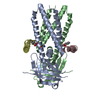
|
|---|---|
| 1 |
|
- Components
Components
| #1: Protein | Mass: 32165.902 Da / Num. of mol.: 2 Source method: isolated from a genetically manipulated source Source: (gene. exp.)  Gene: 3a / Production host:  #2: Protein | Mass: 24647.678 Da / Num. of mol.: 2 / Fragment: UNP residues 79-267 Source method: isolated from a genetically manipulated source Source: (gene. exp.)  Homo sapiens (human) / Gene: APOA1 / Production host: Homo sapiens (human) / Gene: APOA1 / Production host:  #3: Chemical | #4: Water | ChemComp-HOH / | Has ligand of interest | N | |
|---|
-Experimental details
-Experiment
| Experiment | Method: ELECTRON MICROSCOPY |
|---|---|
| EM experiment | Aggregation state: PARTICLE / 3D reconstruction method: single particle reconstruction |
- Sample preparation
Sample preparation
| Component | Name: SARS-CoV-2 protein 3A in lipid nanodiscs / Type: COMPLEX / Entity ID: #1-#2 / Source: RECOMBINANT | |||||||||||||||
|---|---|---|---|---|---|---|---|---|---|---|---|---|---|---|---|---|
| Molecular weight | Value: 0.062 MDa / Experimental value: NO | |||||||||||||||
| Source (natural) | Organism:  | |||||||||||||||
| Source (recombinant) | Organism:  | |||||||||||||||
| Buffer solution | pH: 7.4 | |||||||||||||||
| Buffer component |
| |||||||||||||||
| Specimen | Conc.: 1.1 mg/ml / Embedding applied: NO / Shadowing applied: NO / Staining applied: NO / Vitrification applied: YES | |||||||||||||||
| Specimen support | Grid material: GOLD / Grid mesh size: 300 divisions/in. / Grid type: Quantifoil R1.2/1.3 | |||||||||||||||
| Vitrification | Instrument: FEI VITROBOT MARK IV / Cryogen name: ETHANE / Humidity: 100 % / Chamber temperature: 277 K / Details: 1 blot force 5 second wait time 3 second blot time |
- Electron microscopy imaging
Electron microscopy imaging
| Experimental equipment |  Model: Titan Krios / Image courtesy: FEI Company |
|---|---|
| Microscopy | Model: FEI TITAN KRIOS |
| Electron gun | Electron source:  FIELD EMISSION GUN / Accelerating voltage: 300 kV / Illumination mode: FLOOD BEAM FIELD EMISSION GUN / Accelerating voltage: 300 kV / Illumination mode: FLOOD BEAM |
| Electron lens | Mode: BRIGHT FIELD |
| Image recording | Electron dose: 50 e/Å2 / Film or detector model: FEI FALCON IV (4k x 4k) |
- Processing
Processing
| Software |
| ||||||||||||||||||||||||
|---|---|---|---|---|---|---|---|---|---|---|---|---|---|---|---|---|---|---|---|---|---|---|---|---|---|
| EM software | Name: PHENIX / Version: 1.18.2-3874-000 / Category: model refinement | ||||||||||||||||||||||||
| CTF correction | Type: PHASE FLIPPING AND AMPLITUDE CORRECTION | ||||||||||||||||||||||||
| 3D reconstruction | Resolution: 2.08 Å / Resolution method: FSC 0.143 CUT-OFF / Num. of particles: 91218 / Num. of class averages: 1 / Symmetry type: POINT | ||||||||||||||||||||||||
| Atomic model building | Space: REAL | ||||||||||||||||||||||||
| Refinement | Cross valid method: NONE Stereochemistry target values: GeoStd + Monomer Library + CDL v1.2 | ||||||||||||||||||||||||
| Displacement parameters | Biso mean: 42.33 Å2 | ||||||||||||||||||||||||
| Refine LS restraints |
|
 Movie
Movie Controller
Controller







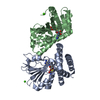
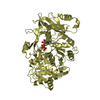
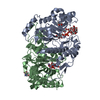
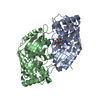
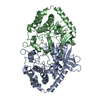
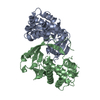
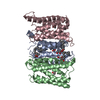
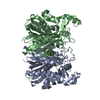

 PDBj
PDBj